Urbanization and Increasing Flood Risk in the Northern Coast of Central Java—Indonesia: An Assessment towards Better Land Use Policy and Flood Management
Abstract
1. Introduction
2. Materials and Methods
2.1. Study Area
2.2. Methods of Data Collection
2.2.1. Spatial Data
2.2.2. Urban and Rural Classification Data
2.2.3. Disaster Data
2.3. Methods of Data Analyses
3. Results or Outcomes
3.1. Land Use Change in the Northern Coast of Java 2009–2018
3.2. Flood Events in the River Basins
3.3. Land Use Change and Flood Phenomenon in River Basins
4. Discussion and Issues Emerging from the Study
4.1. River Basins Have Dual Spatial Identity that Embraces Policy and Land Use Issues in the Urban System
4.2. There Are Several Opportunities to Broaden the Role of Governance in Flood Management
5. Conclusions
Author Contributions
Funding
Acknowledgments
Conflicts of Interest
References
- Deng, X.; Xu, Y. Degrading Flood Regulation Function of River Systems in the Urbanisation Process. Sci. Total Environ. 2018, 622, 1379–1390. [Google Scholar] [CrossRef] [PubMed]
- Miller, M.A.; Douglass, M. (Eds.) Disaster Governance in Urbanising Asia; Springer: Singapore, 2016; pp. 1–12. [Google Scholar]
- Sarauskiene, D.; Kriauciuniene, J.; Reihan, A.; Klavins, M. Flood Pattern Changes in the Rivers of the Baltic Countries. J. Environ. Eng. Landsc. Manag. 2015, 23, 28–38. [Google Scholar] [CrossRef]
- Adhikari, P.; Hong, Y.; Douglas, K.R.; Kirschbaum, D.B.; Gourley, J.; Adler, R.; Brakenridge, G.R. A digitized global flood inventory (1998–2008): Compilation and preliminary results. Nat. Hazards 2010, 55, 405–422. [Google Scholar] [CrossRef]
- Bertilsson, L.; Wiklund, K.; de Moura Tebaldi, I.; Rezende, O.M.; Veról, A.P.; Miguez, M.G. Urban flood resilience—A multi-criteria index to integrate flood resilience into urban planning. J. Hydrol. 2019, 573, 970–982. [Google Scholar] [CrossRef]
- Buchori, I.; Pramitasari, A.; Sugiri, A.; Maryono, M.; Basuki, Y.; Sejati, A.W. Adaptation to coastal flooding and inundation: Mitigations and migration pattern in Semarang City, Indonesia. Ocean Coast. Manag. 2018, 163, 445–455. [Google Scholar] [CrossRef]
- Rudiarto, I.; Handayani, W.; Setyono, J.S. A Regional Perspective on Urbanisation and Climate-Related Disasters in the Northern Coastal Region of Central Java, Indonesia. Land 2018, 7, 34. [Google Scholar] [CrossRef]
- McGranahan, G.; Balk, D.; Anderson, B. The rising tide: Assessing the risks of climate change and human settlements in low elevation coastal zones. Environ. Urban. 2007, 19, 17–37. [Google Scholar] [CrossRef]
- Neumann, B.; Vafeidis, A.T.; Zimmermann, J.; Nicholls, R.J. Future Coastal Population Growth and Exposure to Sea-Level Rise and Coastal Flooding—A Global Assessment. PLoS ONE 2015, 10, e0118571. [Google Scholar] [CrossRef]
- Deng, X.; Xu, Y.; Han, L.; Song, S.; Yang, L.; Li, G.; Wang, Y. Impacts of Urbanisation on River Systems in the Taihu Region, China. Water 2015, 7, 1340–1358. [Google Scholar] [CrossRef]
- Chin, A. Urban Transformation of River Landscapes in A Global Context. Geomorphology 2006, 79, 460–487. [Google Scholar] [CrossRef]
- Chigbu, U.E.; Kalashyan, V. Land-use planning and public administration in Bavaria, Germany: Towards a public administration approach to land-use planning. Geomat. Land Manag. Landsc. 2015, 4, 7–17. [Google Scholar] [CrossRef]
- Hegger, D.L.; Driessen, P.P.; Wiering, M.; Van Rijswick, H.F.; Kundzewicz, Z.W.; Matczak, P.; Crabbé, A.; Raadgever, G.T.; Bakker, M.H.N.; Priest, S.J.; et al. Toward more flood resilience: Is a diversification of flood risk management strategies the way forward? Ecol. Soc. 2016, 21, 52. [Google Scholar] [CrossRef]
- ISDR. Hyogo Framework for Action 2005–2015: Building the Resilience of Nations and Communities to Disasters. In Proceedings of the World Conference on Disaster Reduction, Kobe, Japan, 18–22 January 2005. [Google Scholar]
- UNISDR. Sendai Framework for Disaster Risk Reduction 2015–2030: United Nations International Strategy for Disaster Reduction; UNISDR: Geneva, Switzerland, 2015. [Google Scholar]
- Handayani, W.; Fisher, M.R.; Rudiarto, I.; Setyono, J.S.; Foley, D. Operationalizing resilience: A content analysis of flood disaster planning in two coastal cities in Central Java, Indonesia. Int. J. Disaster Risk Reduct. 2019, 35, 101073. [Google Scholar] [CrossRef]
- Chen, Y.; Xie, W.; Xu, X. Changes of Population, Built-up Land, and Cropland Exposure to Natural Hazards in China from 1995 to 2015. Int. J. Disaster Risk Sci. 2019, 10, 557–572. [Google Scholar] [CrossRef]
- Song, S.; Xu, Y.P.; Wu, Z.F.; Deng, X.J.; Wang, Q. The relative impact of urbanisation and precipitation on long-term water level variations in the Yangtze River Delta. Sci. Total Environ. 2019, 648, 460–471. [Google Scholar] [CrossRef]
- Zhou, Q.; Leng, G.; Su, J.; Ren, Y. Comparison of urbanization and climate change impacts on urban flood volumes: Importance of urban planning and drainage adaptation. Sci. Total Environ. 2019, 658, 24–33. [Google Scholar] [CrossRef]
- Zope, P.E.; Eldho, T.I.; Jothiprakash, V. Impacts of land use–land cover changes and urbanisation on flooding: A case study of Oshiwara River Basin in Mumbai, India. Catena 2016, 145, 142–154. [Google Scholar] [CrossRef]
- Handayani, W.; Rudiarto, I.; Setyono, J.S.; Chigbu, U.E.; Sukmawati, A.M. Vulnerability assessment: A comparison of three different city sizes in the coastal area of Central Java, Indonesia. Adv. Clim. Chang. Res. 2017, 8, 286–296. [Google Scholar] [CrossRef]
- Parkes, M.W.; Morrison, K.E.; Bunch, M.J.; Hallström, L.K.; Neudoerffer, R.C.; Venema, H.D.; Waltner-Toews, D. Towards Integrated Governance for Water, Health and Social-Ecological Systems: The Watershed Governance Prism. Glob. Environ. Chang. 2010, 20, 693–704. [Google Scholar] [CrossRef]
- Gregersen, H.M.; Ffolliott, P.F.; Brooks, K.N. (Eds.) Integrated Watershed Management: Connecting People to Their Land and Water; CABI: Wallingford, UK, 2007. [Google Scholar]
- Handayani, W.; Waskitaningsih, N. Kependudukan dalam Perencanaan Wilayah dan Kota; Teknosain: Yogyakarta, Indonesia, 2019. [Google Scholar]
- Indonesia Government. Presidential Decree No. 12/2012: The Determination of River Areas; Indonesia Government: Jakarta, Indonesia, 2012.
- Central Bureau of Statistics (CBS). Head of Central Bureau of Statistics Regulation No. 37/2010: Urban Rural Classification in Indonesia; CBS: Jakarta, Indonesia, 2010.
- Indonesia Government. Law No. 24/2007: Disaster Management; Indonesia Government: Jakarta, Indonesia, 2007.
- National Standardization Agency of Indonesia. Indonesian National Standard Regulation Number 7645: 2010 Land Cover Classification; National Standardization Agency of Indonesia: Jakarta, Indonesia, 2010.
- Central Java Government. Governor of Central Java Regulation No. 46/2012: The Provincial Level of Forestry Plan 2011–2030; Central Java Government: Central Java, Indonesia, 2012.
- Indonesian Ministry of Environment and Forestry. Minister of Environment and Forestry Regulation No. P.41/MENLHK/SETJEN/KUM.1/7/2019: The National Level of Forestry Plan 2011–2030; Indonesian Ministry of Environment and Forestry: Jakarta, Indonesia, 2019.
- MCGA (Meteorological, Climatological, and Geophysical Agency). Data Online—Data Iklim: Pusat Database BMKG, Semarang-Indonesia, 2014. Available online: http://dataonline.bmkg.go.id/data_iklim (accessed on 15 April 2019).
- MCGA (Meteorological, Climatological, and Geophysical Agency). Data Online—Data Iklim: Pusat Database BMKG, Semarang-Indonesia, 2015. Available online: http://dataonline.bmkg.go.id/data_iklim (accessed on 15 April 2019).
- MCGA (Meteorological, Climatological, and Geophysical Agency). Data Online—Data Iklim: Pusat Database BMKG, Semarang-Indonesia, 2016. Available online: http://dataonline.bmkg.go.id/data_iklim (accessed on 15 April 2019).
- MCGA (Meteorological, Climatological, and Geophysical Agency). Data Online—Data Iklim: Pusat Database BMKG, Semarang-Indonesia, 2017. Available online: http://dataonline.bmkg.go.id/data_iklim (accessed on 15 April 2019).
- Siswanto, S.; Supari, S. Rainfall Changes Over Java Island, Indonesia. J. Environ. Earth Sci. 2015, 5, 1–10. [Google Scholar]
- Kendal Disaster Management Agency. Banjir Limpas Sungai Kendal. 2019. Available online: http://bpbd.kendalkab.go.id/berita/id/20190127001/banjir_limpas_sungai_kendal (accessed on 15 April 2019).
- Pawitan, H. Perubahan Penggunaan Lahan dan Pengaruhnya Terhadap Hidrologi Daerah Aliran Sungai (Effect of Land Use Change to the Hydrology in Watersheds); Laboratorium Hidrometeorologi FMIPA IPB: Bogor, Indonesia, 2004. [Google Scholar]
- Central Bureau of Statistics (CBS). Statistik Indonesia 2018 (Indonesian Statistic 2018); Central Bureau of Statistics: Jakarta, Indonesia, 2018.
- Avia, L.Q. Change in Rainfall Per-Decades over Java Island, Indonesia. IOP Conf. Ser.: Earth Environ. Sci. 2019, 374, 012037. [Google Scholar] [CrossRef]
- Dewi, R.S.; Bijker, W. Dynamics of Shoreline Changes in the Coastal Region of Sayung, Indonesia. Egypt. J. Remote Sens. Space Sci. 2020, 23, 181–193. [Google Scholar] [CrossRef]
- Water as Leverage for Resilient Cities Asia Program. One Resilient Semarang: Volume II Concept Design Proposals Final Report; Water as Leverage Consortium Project Report: Semarang, Indonesia, 2019. [Google Scholar]
- Rudiarto, I.; Pamungkas, D. Spatial Exposure and Livelihood Vulnerability to Climate-Related Disasters in the North Coast of Tegal City, Indonesia. Int. Rev. Spat. Plan. Sustain. Dev. 2020, 8, 34–53. [Google Scholar] [CrossRef]
- Rudiarto, I.; Handayani, W.; Wijaya, H.B.; Insani, T.D. Land Resource Availability and Climate Change Disasters in the Rural Coastal of Central Java–Indonesia. IOP Conf. Ser. Earth Environ. Sci. 2018, 202, 012029. [Google Scholar] [CrossRef]
- Handayani, W. Rural-urban transition in Central Java: Population and economic structural changes based on cluster analysis. Land 2013, 2, 419–436. [Google Scholar] [CrossRef]
- Das, S.; Teron, R.; Duary, B.; Bhattacharya, S.S.; Kim, K.H. Assessing C–N balance and soil rejuvenation capacity of vermicompost application in a degraded landscape: A study in an alluvial river basin with Cajanus cajan. Environ. Res. 2019, 177, 108591. [Google Scholar] [CrossRef] [PubMed]
- Fleischhauer, E.; Eger, H. Can Sustainable Land Use be Achieved? An Introductory View on Scientific and Political Views. In Towards Sustainable Land Use: Furthering Cooperation between People and Institutions; Blume, H.P., Eger, H., Fleischhauer, E., Hebel, A., Reij, C., Steiner, K.G., Eds.; Catena Verlag GMBh: Reiskirchen, Germany, 1998; Volume 1, pp. xix–xxxii. [Google Scholar]
- Gwaleba, M.J.; Chigbu, U.E. Participation in Property Formation: Insights from Land-Use Planning in an Informal Urban Settlement in Tanzania. Land Use Policy 2020, 92, 104482. [Google Scholar] [CrossRef]
- Yao, R.; Wang, L.; Gui, X.; Zheng, Y.; Zhang, H.; Huang, X. Urbanisation Effects on Vegetation and Surface Urban Heat Islands in China’s Yangtze River Basin. Remote Sens. 2017, 9, 540. [Google Scholar] [CrossRef]
- Zhanlu, Z.; Zhang, Z. Land Use Planning; China Renmin University Press: Beijing, China, 2006. [Google Scholar]
- Wang, W.; Han, T. Land Use Planning; China Agriculture Press: Beijing, China, 2013. [Google Scholar]
- Handayani, W.; Rudiarto, I. Dynamics of urban growth in Semarang Metropolitan-Central Java: An examination based on built-up area and population change. J. Geogr. Geol. 2014, 6, 80. [Google Scholar] [CrossRef]
- Miller, J.D.; Hutchins, M. The Impacts of Urbanisation and Climate Change on Urban Flooding and Urban Water Quality: A Review of the Evidence Concerning the United Kingdom. J. Hydrol. Reg. Stud. 2017, 12, 345–362. [Google Scholar] [CrossRef]
- Haryani, G.S. Ecohydrology in Indonesia: Emerging Challenges and Its Future Pathways. Ecohydrol. Hydrobiol. 2016, 16, 112–116. [Google Scholar] [CrossRef]
- Fatch, J.J.; Manzungu, E.; Mabiza, C. Problematising and Conceptualising Local Participation in Transboundary Water Resources Management: The Case of Limpopo River Basin in Zimbabwe. Phys. Chem. Earth Parts A/B/C 2010, 35, 838–847. [Google Scholar] [CrossRef]
- Friend, R.; Jarvie, J.; Reed, S.O.; Sutarto, R.; Thinphanga, P.; Toan, V.C. Mainstreaming urban climate resilience into policy and planning; reflections from Asia. Urban Clim. 2014, 7, 6–19. [Google Scholar] [CrossRef]
- Tierney, K. Disaster Governance: Social, Political, and Economic Dimensions. Annu. Rev. Environ. Resour. 2012, 37, 341–363. [Google Scholar] [CrossRef]
- Pardoe, J.; Penning-Rowsell, E.; Tunstall, S. Floodplain Conflicts: Regulation and Negotiation. Nat. Hazards Earth Syst. Sci. 2011, 11, 2889–2902. [Google Scholar] [CrossRef]
- Heintz, M.D.; Hagemeier-Klose, M.; Wagner, K. Towards A Risk Governance Culture in Flood Policy—Findings from the Implementation of the “Floods Directive” in Germany. Water 2012, 4, 135–156. [Google Scholar] [CrossRef]
- Raikes, J.; Smith, T.F.; Jacobson, C.; Baldwin, C. Pre-disaster Planning and Preparedness for Floods and Droughts: A Systematic Review. Int. J. Disaster Risk Reduct. 2019, 38, 101207. [Google Scholar] [CrossRef]
- Rijke, J.; Van Herk, S.; Zevenbergen, C.; Ashley, R. Room for The River: Delivering Integrated River Basin Management in The Netherlands. Int. J. River Basin Manag. 2012, 10, 369–382. [Google Scholar] [CrossRef]
- Jones, P.; Macdonald, N. Making Space for Unruly Water: Sustainable Drainage Systems and the Disciplining of Surface Runoff. Geoforum 2007, 38, 534–544. [Google Scholar] [CrossRef]
- Bae, S.; Chang, H. Urbanisation and Floods in the Seoul Metropolitan Area of South Korea: What Old Maps Tell Us. Int. J. Disaster Risk Reduct. 2019, 37, 101186. [Google Scholar] [CrossRef]
- Zhang, W.; Villarini, G.; Vecchi, G.A.; Smith, J.A. Urbanisation Exacerbated the Rainfall and Flooding Caused by Hurricane Harvey in Houston. Nature 2018, 563, 384–388. [Google Scholar] [CrossRef] [PubMed]

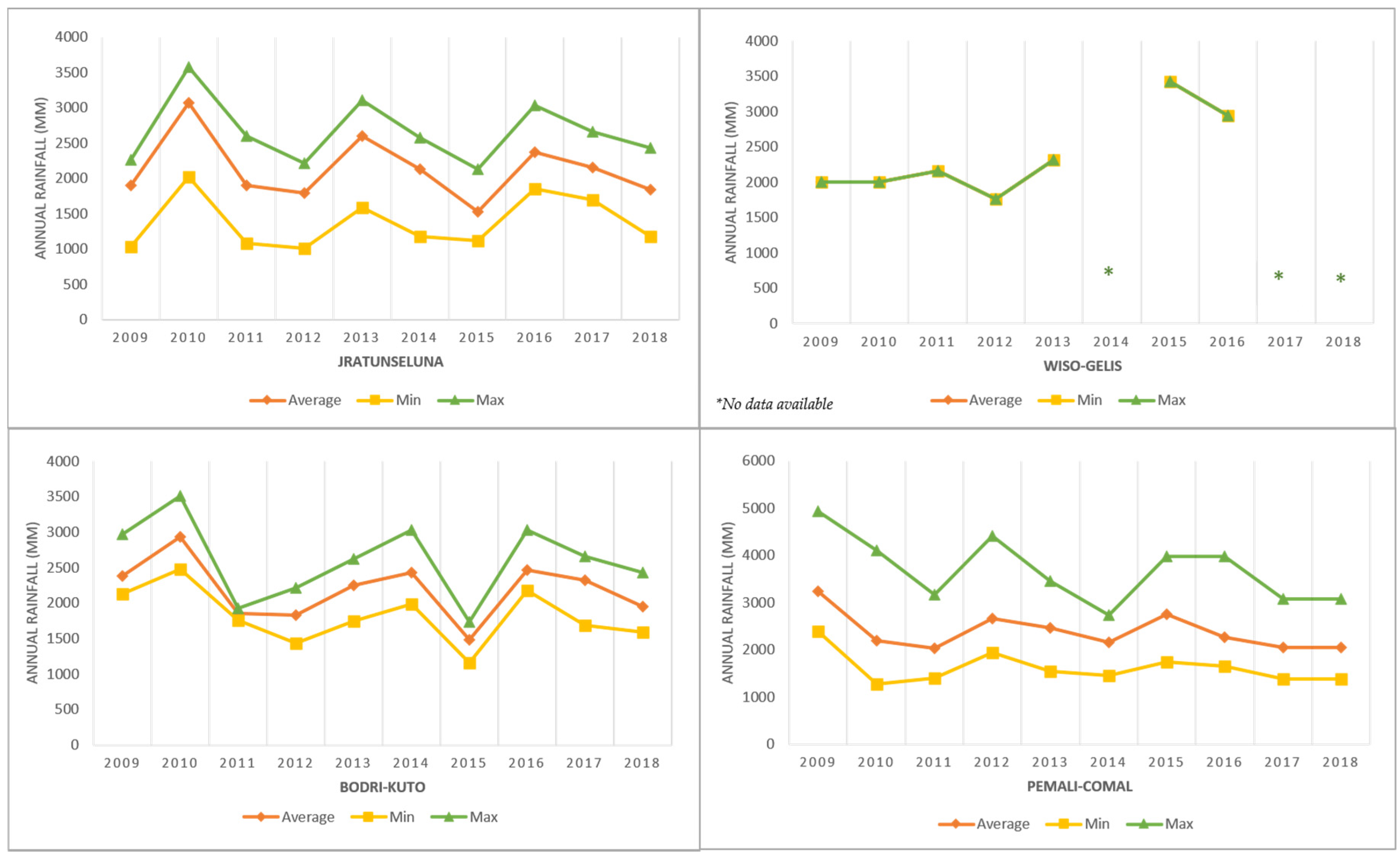
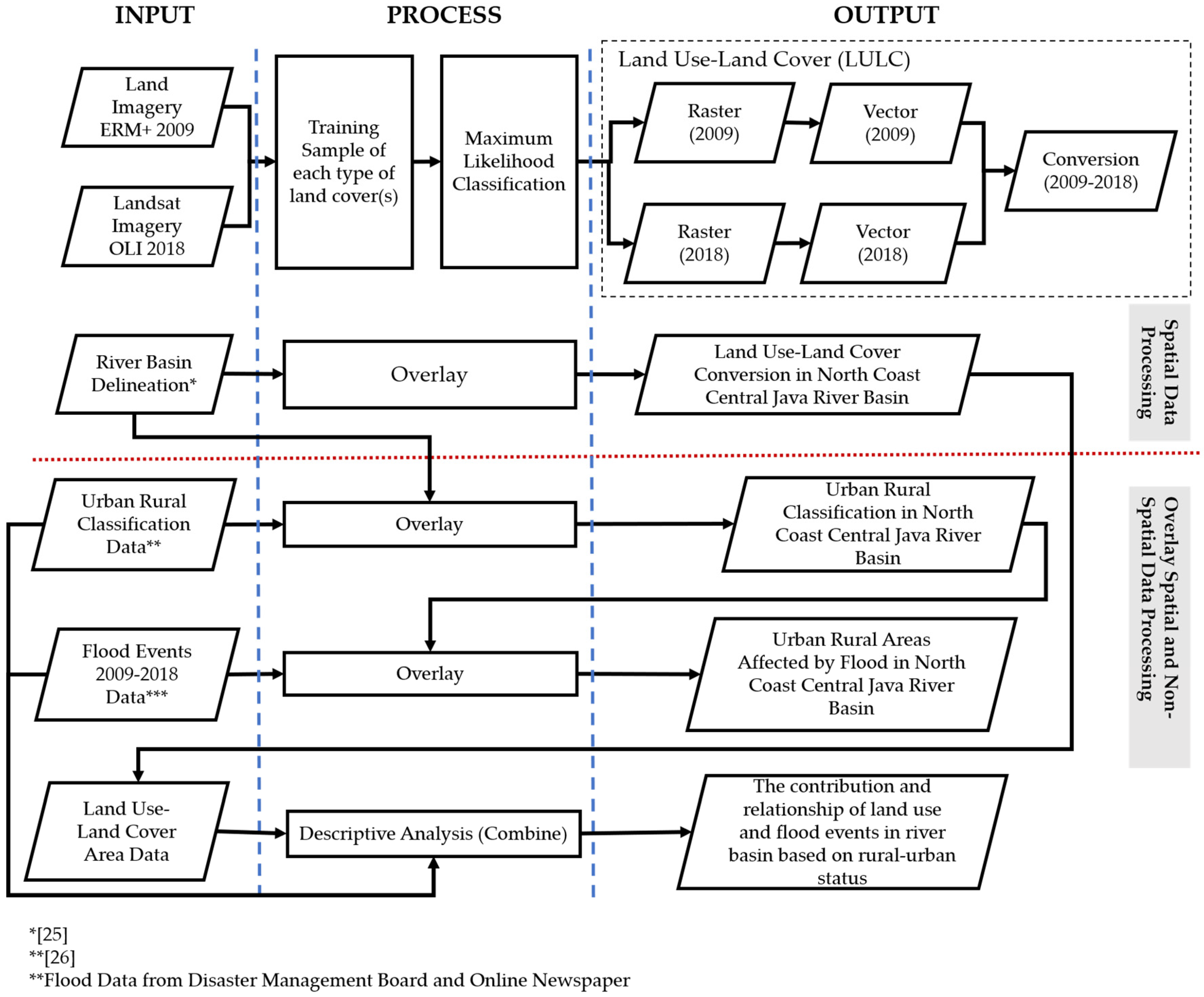
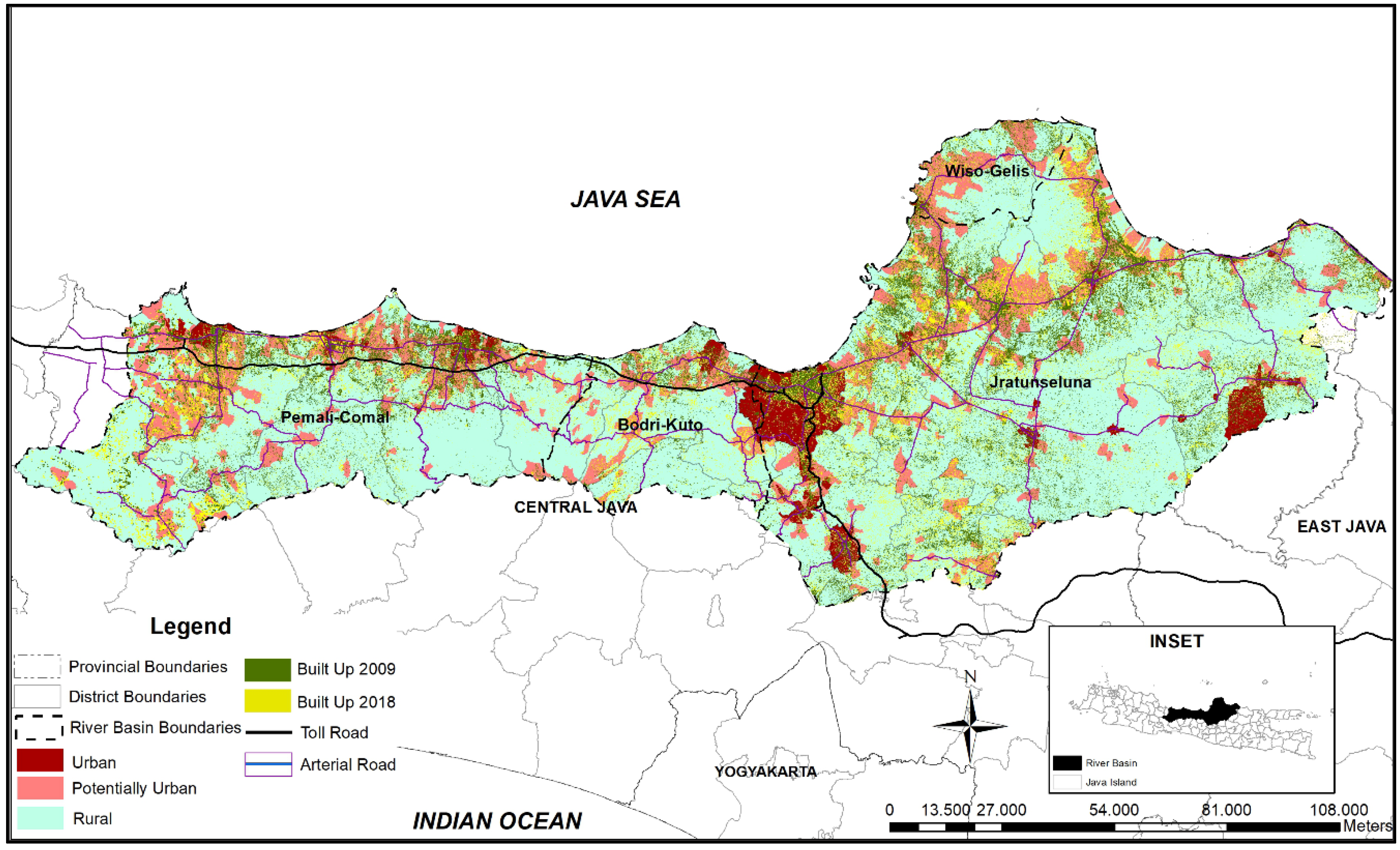
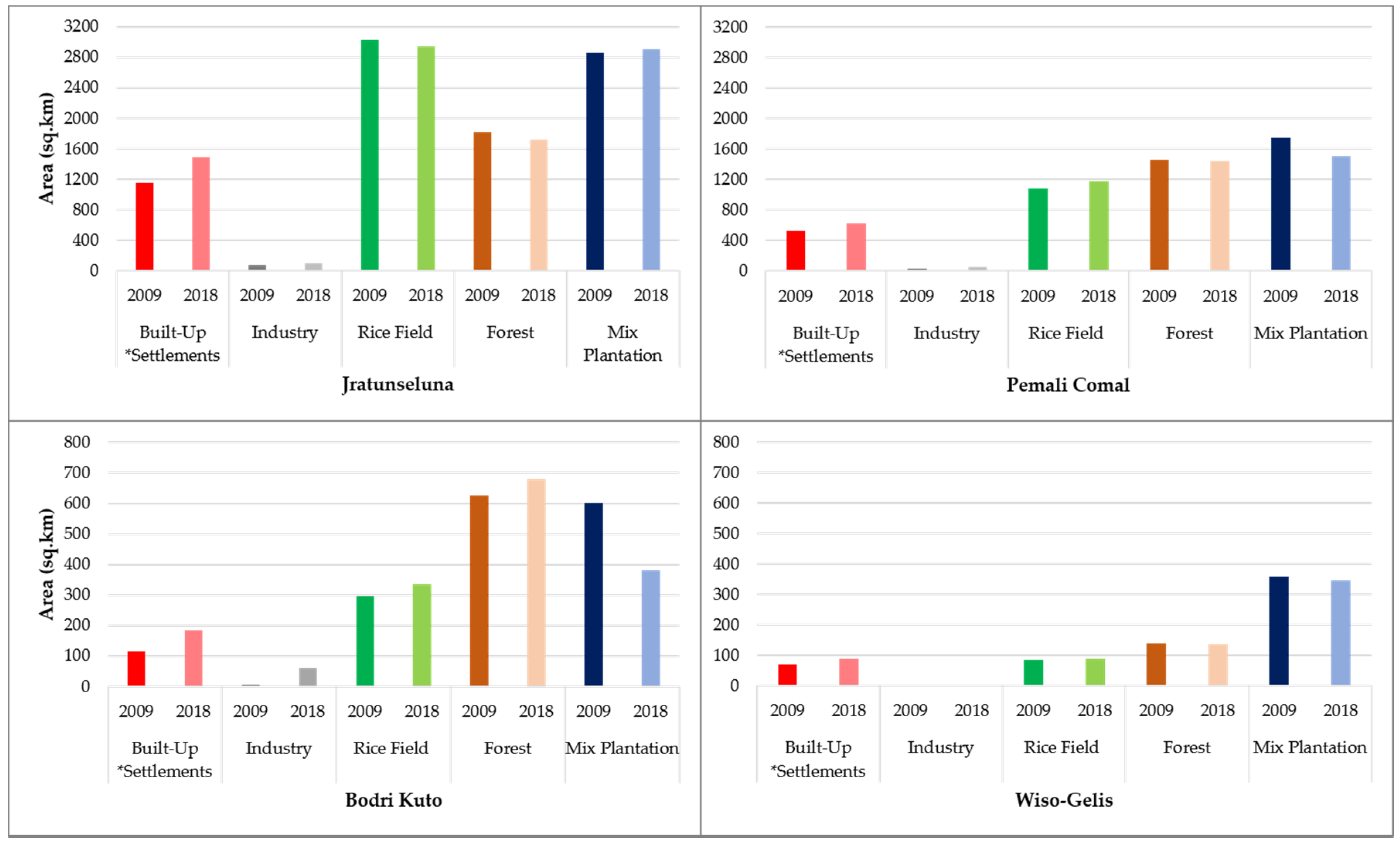
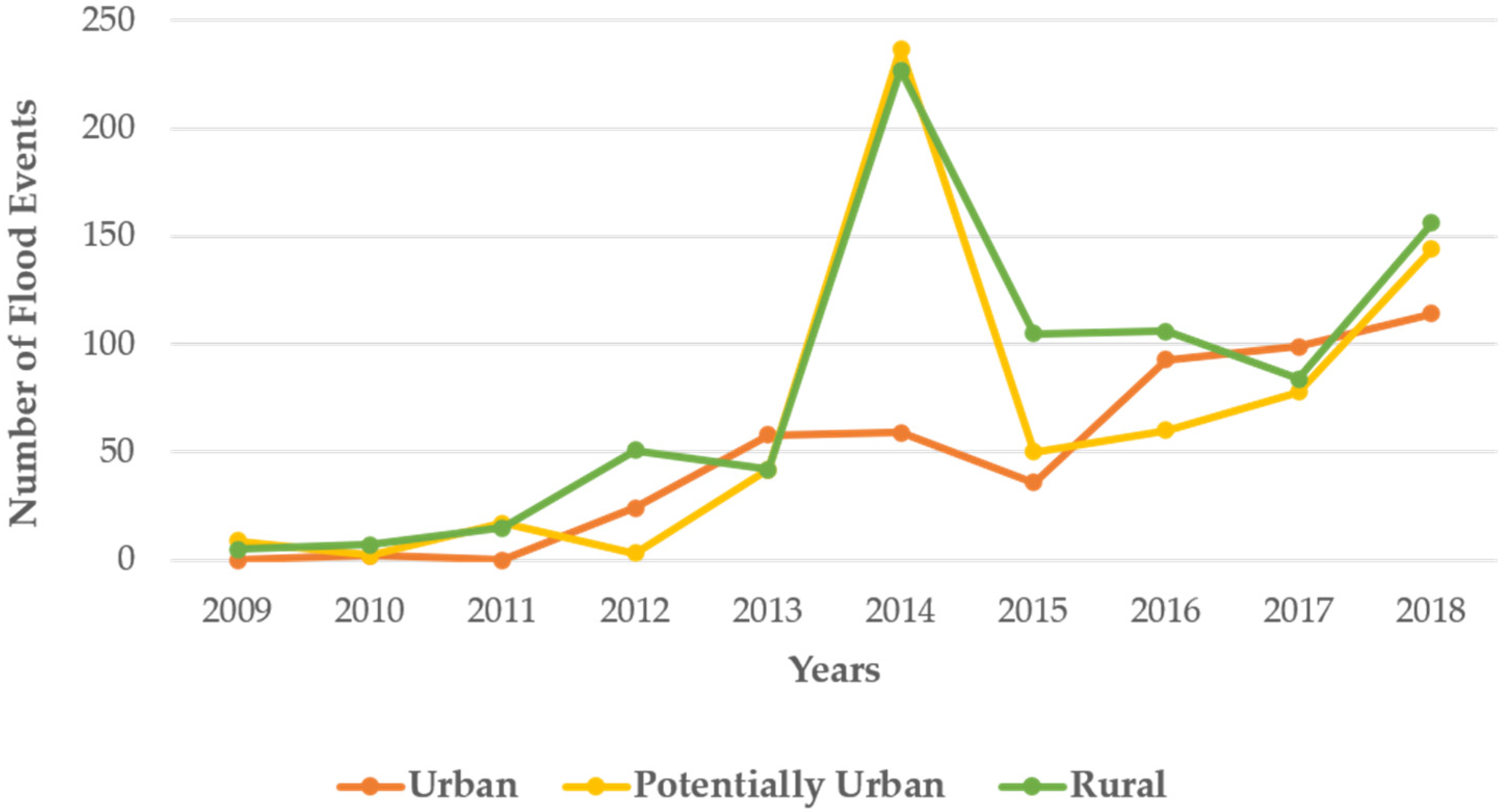
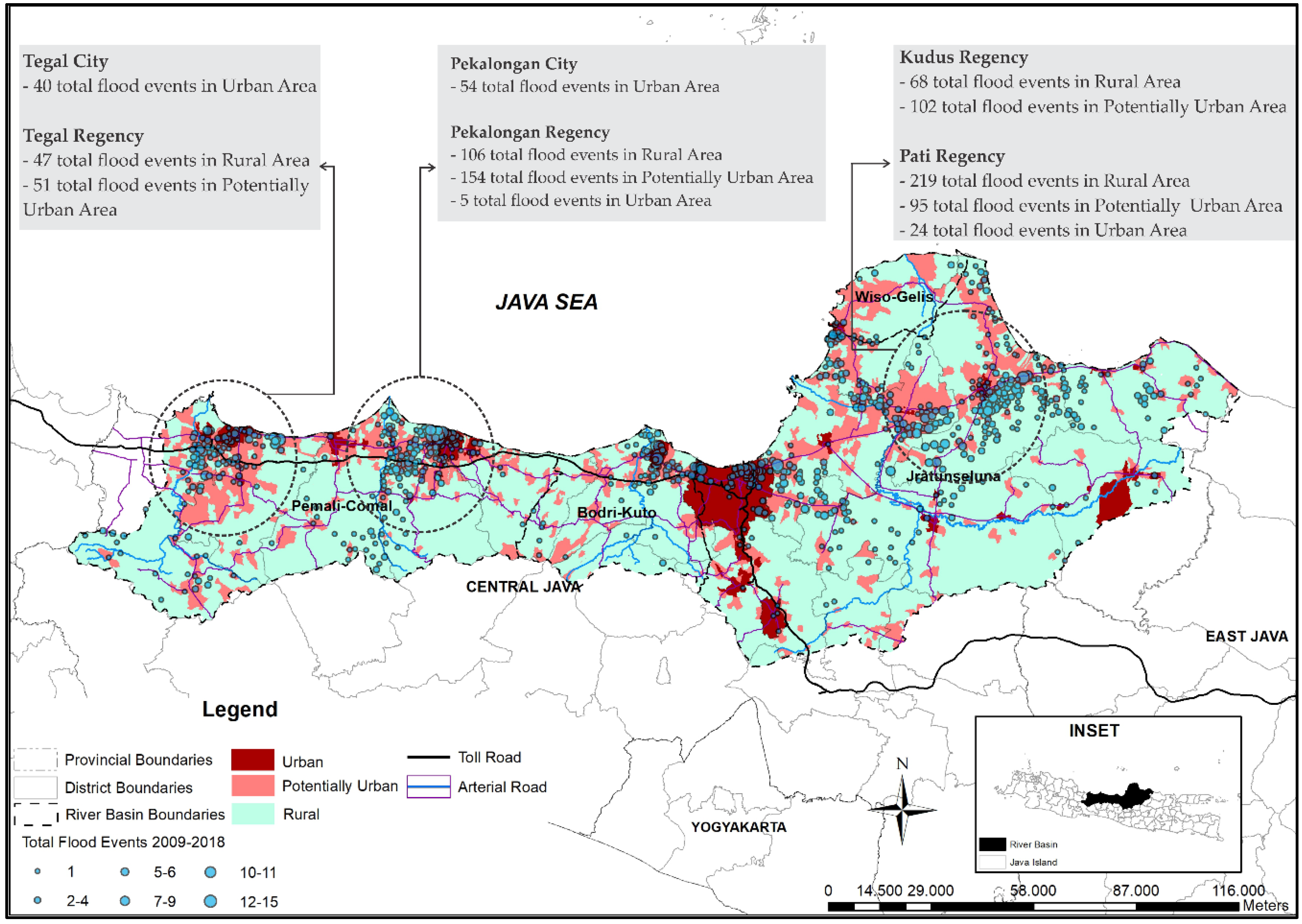
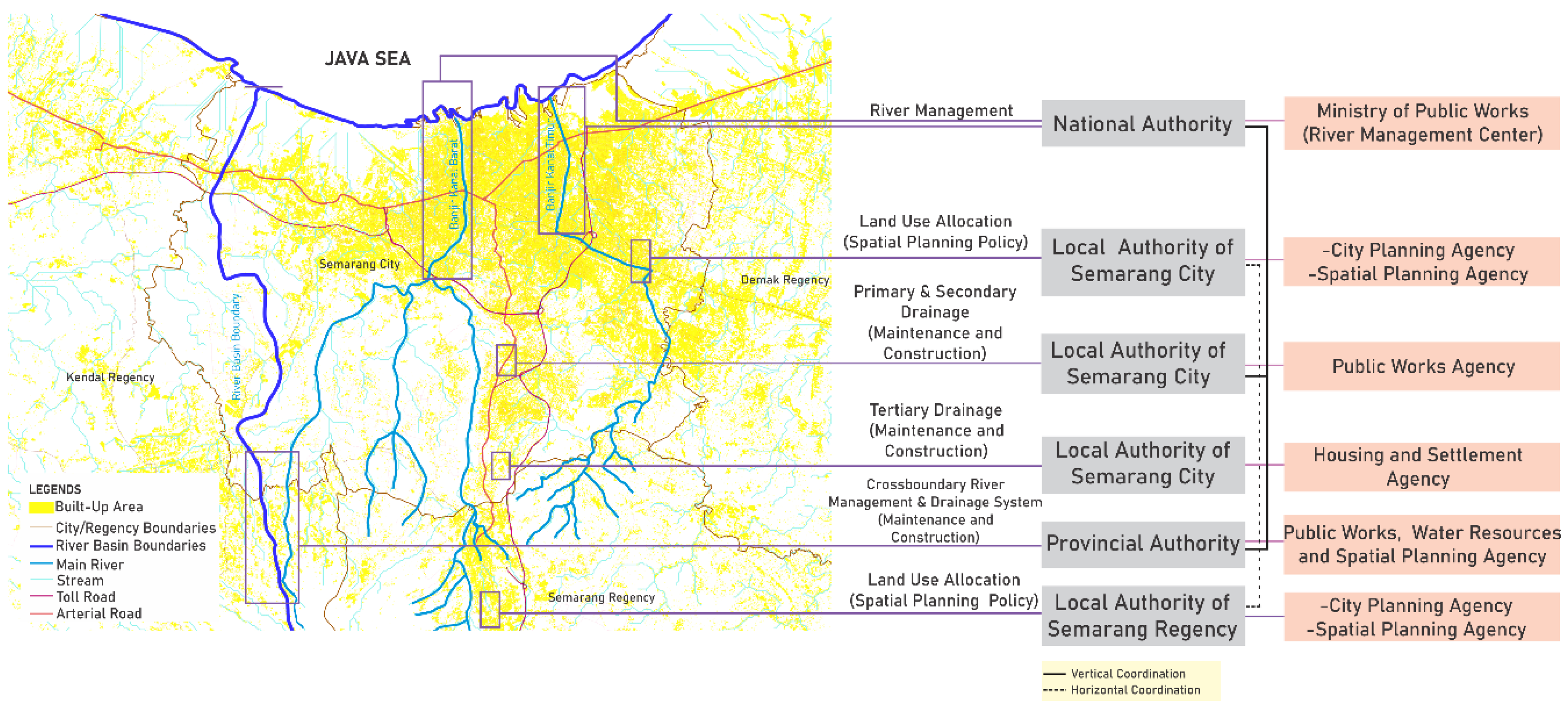
| River Basin | Area (km2) | Watershed | Territorial Areas of Jurisdiction | Population |
|---|---|---|---|---|
| Jratunseluna | 9216 | 69 | 10 Regencies, 2 Cities (2231 Villages/Kelurahan) | 8.9 million |
| Wiso-Gelis | 663 | 27 | 1 Regency (92 Villages/Kelurahan) | 1.2 million |
| Bodri-Kuto | 1662 | 12 | 3 Regencies (396 Villages/Kelurahan) | 1.3 million |
| Pemali-Comal | 4860 | 32 | 4 Regencies, 2 Cities (961 Villages/Kelurahan) | 6.9 million |
| No | Data Type | Year | Data Format | Source |
|---|---|---|---|---|
| 1 | Landsat 8 Satellite Image | 2009 and 2018 | Image | United States Geological Survey (USGS) |
| 2 | Watershed delineation | 2018 | Shapefile | Presidential Decree No. 12/2012 Ministry of Environment and Forestry |
| No | Classification | Definition | Delineation |
|---|---|---|---|
| 1 | Urban area | Consist of kelurahan (located in cities) and urban villages (as capital of regency) | Jurisdiction based on government regulation |
| 2 | Potentially Urban Area | Consist of villages (desa) that are characterized as urban, located in regencies |
|
| 3 | Rural Area | Consist of villages (desa) that are located in regencies | The rest of the area |
| Sources | Total Incidents Reported | Contributions (%) |
|---|---|---|
| Formal Government Report | ||
| Disaster Management Board of Central Java Province | 1104 | 52.00 |
| Online Newspapers | ||
| Tribune News | 107 | 5.04 |
| Kompas | 86 | 4.05 |
| Sindo Newa | 63 | 2.97 |
| Detik News | 60 | 2.83 |
| Others Media (85 Media which reported less than 60 incidents) | 703 | 33.11 |
| Total | 2123 | 100 |
| Land Use Type | Description |
|---|---|
| Built-up-Settlement | Land covered by buildings, dominated by grey color, are likely to cluster and/or to be built around the road network. |
| Built-up-Industry | Land covered by big buildings, dominated by light grey/white color, are likely to cluster and/or to be built around the road network. |
| Rice field | Land for agricultural with or without slopping terraces, dominated by light green color, mostly characterized as a dike pattern with a smooth texture |
| Forest | Natural and man-made forests, approximately 75% covered by trees, dominated by dark green color and a rough texture. |
| Mix Plantation | Different types of vegetation with various density, the color and texture are in between that of the rice fields and forests. |
| River Basin | Area (km2) | Average Annual Growth Rate (%) | ||
|---|---|---|---|---|
| 2009 | 2018 | Change (%) | ||
| Built-Up | Built-Up | |||
| Jratunseluna | 1222.58 | 1581.26 | 29.34 | 3.26 |
| Urban | 89.19 | 211.93 | 137.62 | 15.29 |
| Potentially Urban | 330.88 | 467.69 | 41.35 | 4.59 |
| Rural | 802.51 | 901.64 | 12.35 | 1.37 |
| Wiso-Gelis | 70.72 | 89.81 | 26.99 | 3.00 |
| Urban | 2.38 | 2.62 | 10.08 | 1.12 |
| Potentially Urban | 31.42 | 36.93 | 17.54 | 1.95 |
| Rural | 36.92 | 50.26 | 36.13 | 4.01 |
| Bodri-Kuto | 117.17 | 244.56 | 108.72 | 12.08 |
| Urban | 12.34 | 17.4 | 41.00 | 4.56 |
| Potentially Urban | 41.51 | 88.39 | 112.94 | 12.55 |
| Rural | 63.32 | 138.77 | 119.16 | 13.24 |
| Pemali-Comal | 556.14 | 670.71 | 20.60 | 2.29 |
| Urban | 63.27 | 69.7 | 10.16 | 1.13 |
| Potentially Urban | 204.47 | 293.02 | 43.31 | 4.81 |
| Rural | 288.4 | 307.99 | 6.79 | 0.75 |
| River Basin | Land Use Contribution (%) | Flood Events Contribution (%) | Total Flood Events Contribution 2009–2018 (%) | ||||||||||||
|---|---|---|---|---|---|---|---|---|---|---|---|---|---|---|---|
| 2009 | 2018 | ||||||||||||||
| Built-Up | Non-Built Up | Built-Up | Non-Built Up | 2009 | 2010 | 2011 | 2012 | 2013 | 2014 | 2015 | 2016 | 2017 | 2018 | ||
| Jratunseluna | |||||||||||||||
| Urban | 1.0 | 3.7 | 2.3 | 4.8 | 0.0 | 16.7 | 20.4 | 20.4 | 35.4 | 7.7 | 16.7 | 30.2 | 27.0 | 23.0 | 20.3 |
| Potentially Urban | 3.7 | 14.6 | 5.1 | 12.7 | 42.9 | 0.0 | 6.1 | 6.1 | 31.3 | 46.9 | 23.3 | 18.8 | 31.2 | 31.0 | 31.6 |
| Rural | 9.0 | 68.0 | 9.9 | 65.1 | 57.1 | 83.3 | 73.5 | 73.5 | 33.3 | 45.4 | 60.0 | 51.0 | 41.8 | 46.0 | 48.2 |
| Total | 13.7 | 86.3 | 17.3 | 82.7 | |||||||||||
| 100 | 100 | 100 | 100 | 100 | 100 | 100 | 100 | 100 | 100 | 100 | 100 | 100 | |||
| Wiso-Gelis | |||||||||||||||
| Urban | 0.4 | 0.3 | 0.4 | 0.2 | 0.0 | 0.0 | 0.0 | 0.0 | 0.0 | 40.0 | 100 | 50.0 | 0.0 | 0.0 | 35.3 |
| Potentially Urban | 4.8 | 31.1 | 5.6 | 28.9 | 0.0 | 0.0 | 0.0 | 0.0 | 0.0 | 20.0 | 0.0 | 33.3 | 0.0 | 0.0 | 17.7 |
| Rural | 5.6 | 57.8 | 7.6 | 57.3 | 0.0 | 0.0 | 0.0 | 0.0 | 100 | 40.0 | 0.0 | 16.7 | 0.0 | 100 | 47.1 |
| Total | 10.8 | 89.2 | 13.6 | 86.4 | |||||||||||
| 100 | 100 | 0.0 | 0.0 | 0.0 | 0.0 | 100 | 100 | 100 | 100 | 100 | 100 | 100 | |||
| Bodri-Kuto | |||||||||||||||
| Urban | 0.8 | 3.9 | 1.1 | 3.6 | 0.0 | 100 | 0.0 | 87.5 | 42.3 | 54.5 | 100 | 57.7 | 85.7 | 50.9 | 59.4 |
| Potentially Urban | 2.5 | 16.9 | 5.4 | 14.1 | 100 | 0.0 | 0.0 | 0.0 | 26.9 | 22.7 | 0.0 | 11.5 | 9.5 | 24.5 | 20.0 |
| Rural | 3.9 | 72.0 | 8.5 | 67.4 | 0.0 | 0.0 | 0.0 | 12.5 | 30.8 | 22.7 | 0.0 | 30.8 | 4.8 | 24.5 | 20.6 |
| Total | 7.1 | 92.9 | 14.9 | 85.1 | |||||||||||
| 100 | 100 | 100 | 100 | 0.0 | 100 | 100 | 100 | 100 | 100 | 100 | 100 | 100 | |||
| Pemali-Comal | |||||||||||||||
| Urban | 1.3 | 2.3 | 1.5 | 2.2 | 0.0 | 0.0 | 0.0 | 0.0 | 68.4 | 10.6 | 9.8 | 38.5 | 43.4 | 26.1 | 23.6 |
| Potentially Urban | 4.2 | 19.8 | 6.1 | 17.8 | 0.0 | 50.0 | 100 | 0.0 | 26.3 | 46.2 | 36.1 | 34.6 | 32.3 | 43.9 | 40.1 |
| Rural | 6.0 | 66.5 | 6.4 | 66.1 | 100 | 50.0 | 0.0 | 100 | 5.3 | 43.2 | 54.1 | 26.9 | 24.2 | 29.9 | 36.4 |
| Total | 11.5 | 88.5 | 14.0 | 86.0 | |||||||||||
| 100 | 100 | 100 | 100 | 100 | 100 | 100 | 100 | 100 | 100 | 100 | 100 | 100 | |||
© 2020 by the authors. Licensee MDPI, Basel, Switzerland. This article is an open access article distributed under the terms and conditions of the Creative Commons Attribution (CC BY) license (http://creativecommons.org/licenses/by/4.0/).
Share and Cite
Handayani, W.; Chigbu, U.E.; Rudiarto, I.; Putri, I.H.S. Urbanization and Increasing Flood Risk in the Northern Coast of Central Java—Indonesia: An Assessment towards Better Land Use Policy and Flood Management. Land 2020, 9, 343. https://doi.org/10.3390/land9100343
Handayani W, Chigbu UE, Rudiarto I, Putri IHS. Urbanization and Increasing Flood Risk in the Northern Coast of Central Java—Indonesia: An Assessment towards Better Land Use Policy and Flood Management. Land. 2020; 9(10):343. https://doi.org/10.3390/land9100343
Chicago/Turabian StyleHandayani, Wiwandari, Uchendu Eugene Chigbu, Iwan Rudiarto, and Intan Hapsari Surya Putri. 2020. "Urbanization and Increasing Flood Risk in the Northern Coast of Central Java—Indonesia: An Assessment towards Better Land Use Policy and Flood Management" Land 9, no. 10: 343. https://doi.org/10.3390/land9100343
APA StyleHandayani, W., Chigbu, U. E., Rudiarto, I., & Putri, I. H. S. (2020). Urbanization and Increasing Flood Risk in the Northern Coast of Central Java—Indonesia: An Assessment towards Better Land Use Policy and Flood Management. Land, 9(10), 343. https://doi.org/10.3390/land9100343








